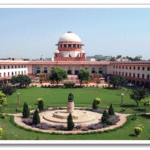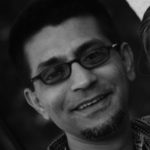A Four-part Journey Through South India in Search of LGBT life
Also see:
Islam and Homosexuality
Gay India Stories
Gay India News & Reports 2000 to present
Gay India Photo Galleries
Read this historic story first
Bangalore
Bangalore is another of India’s forward-leaning mega-cities. In the center of the country and at an altitude of 3000 feet it bakes less than Delhi or Calcutta (Kolkota). The weather was quite pleasant (ignoring the pollution) in late November when we arrived by train from Mysore.
(A note about land travel: during our trip we traveled by motor-rickshaw, taxi, bus, van, train and plane—no ox cart.
Early in our planning we thought about renting a car and driving ourselves around the country; this was highly discouraged and we found out why. There are few road signs (fewer in English), many roads are pot-holed or under repair and, most of all, Indian drivers—especially bus drivers–are suicidal and homicidal.
They drive fast and aggressively wherever possible, recklessly and with horns at full throttle. It is a nerve racking experience for visitors but native drivers are skilled at this. Nevertheless, everything eventually travels at the speed of the slowest vehicle which is often an overloaded rickshaw packed with sacks of rice or an ox cart stacked high with hay. I suggest train travel as the mostly reliable, calmest and safest way to go. )
Bangalore is a prosperous city resulting from high tech manufacturing and global outsourcing boom that has occurred in the past decade. Bangalore Is called the Silicon Valley of India and it’s reflected in the noticeably increased number of shiny Japanese cars and SUVs jamming the streets. The city is also replete with sleek glass and stone buildings housing software companies, chip makers and banking services. Downtown along Curzon Street are high fashion shops and trendy restaurants and dance clubs. 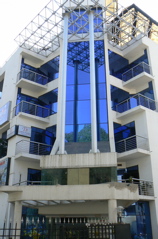
But you won’t find much in the way of a gay restaurant, club or bar. There are no rainbow flags flying above Bangalore. Despite its size of nearly 8 million there is no visible LGBT ‘scene’. There are places where gays may congregate for a weekly stag night but the venues are not identifiable as gay. A friend casually pointed to a Chinese restaurant as we walked past one evening. “This is place is gay on Saturday nights.” How do people know that, I asked. “Local gossip travels quickly.”
More common gathering places are private parties–where donations to NGOs (non-governmental charity organization) are sometimes solicited–given by mid and upscale gays (singles and couples) who have a home and can afford hosting.
As in other major cities there are organizations where gays organize around LGBT, HIV-AIDS, MSM and Human Rights issues and activities. Indeed, someone suggested glibly that if you want to find the gay community in Bangalore participate in an NGO.
In the heart of the city I met three leaders of different health/HIV/Human Rights organizations:
Chandra Balachandran of the Dharani Trust
Vinay Chandran from Swabhava
Reginald (Rex) Watts from Sangama.
Chanrda and Dharani
Chandra Balachandran is a PhD geographer by education a teacher by profession and the founder of the Dharani Trust. The mission of Dharani, according to it website, is: (1) to promote inter-cultural understanding among people of diverse cultures; (2) to promote understanding of human, environmental, and human-environmental interactions to empower people; (3) to provide a forum for academic research and activist work to benefit from each other; (4) to address and promote issues of human rights for marginalized people.
In short, Chandra is an organizational consultant whose aim is to bring together academic research and grass roots activity to make humanistic organizations as effective as possible. Dharani does not deal directly with the HIV/MSM population but works to support, connect and advise organizations on the front lines of health education and human rights. Chandra offers seminars and forums and co-sponsors conferences which bring together academicians, NGO leaders and staff as well as performance artists to share experiences.
“ People need to know and understand one another in order to work together against ignorance, social discrimination and physical disease,” he said.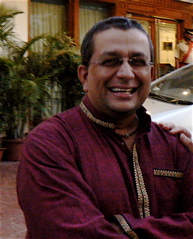
Over a dinner at the chic Patio restaurant in the MacIver Town neighborhood, our conversation ranged over several topics:
Indian lesbians: there are many in Bangalore but they keep separate from the men; most have a curfew of 6 to 7 PM daily since they live with their parents until marriage; they have private small social organizations of their own and nearly all will marry according to custom.
Hinduism and homosexuality: the literary mythology of Hinduism is filled with sexual tales and poems, modern and ancient. The major gods Shiva and Krishna are very sexual beings. It is an amalgamated religion that incorporates numerous beliefs and, originally, no particular opinion about same sex intimacy.
Bangalore gay ‘scene’: a primary social group called ‘Good as You’ meets weekly at the Swabhava office; the activist organization Sangama organizes rights marches and social events; a Chinese restaurant is owned by a gay man and Saturday is boys night; private parties and film nights happen regularly; although mostly hidden, “queer spaces are especially important for young people and help them shorten the course from questioning to LGBT self-identity and maturity”
I asked why there were no visible gay venues in a city as large as Bangalore.
Chandra: “There really is no demand for the western style bar-club-sauna here. Instead there are ‘networks’ and informal affiliations that serve the different communities such as kothis (effeminate gay men) who feel more comfortable with their own ‘kind’ than with upscale preppie gays. Remember we are a segregated society where classes (castes) don’t mix. Only a small percent of gays embrace the western bodybeautiful-rainbow-public-political-activist gay lifestyle; friendship circles feel more natural than circuit parties.”
He continued: India is both forward and backward; we like progress yet we fear it. Traditions are strong and hold onto people. Where else do you find high tech PhD engineers still living with their parents at the age of 40? It’s too incongruous to find a highly visible out LGBT leader in a parade still living at home with his conservative Hindu or Muslim or Christian parents. Family honor is a blessing and a curse—it keep families together and gay people apart.
What would an Indian gay scene look like, what is a possible model?
Chandra replied rather obliquely: “To enact a gay identity here it’s more important to have a resonance rather than a presence, a felt understanding rather than a visible in-your-face model or show. Despite a couple of the occasional small muted ‘parades’ (in Calcutta and Bombay) the Christopher Street West preppie gay model will not happen here—ever.
“I think the Indian model is more subtle and demands indigenous forms that might not even appear gay. A classical dancer may be a masculine man who shaves every day but his performance will be very feminine and soft and yet acceptable as natural to a non-gay observer.
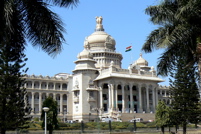 “If you can understand why straight men here are attracted to kothis you may perhaps see my point. These mostly heterosexual guys, even though married, will cruise and flirt with kothis, other men. There is a unspoken mysterious draw to the feminine male that’s appealing to them—and the appeal cuts across caste lines, unlike normal social intercourse.”
“If you can understand why straight men here are attracted to kothis you may perhaps see my point. These mostly heterosexual guys, even though married, will cruise and flirt with kothis, other men. There is a unspoken mysterious draw to the feminine male that’s appealing to them—and the appeal cuts across caste lines, unlike normal social intercourse.”
I replied that I had an occasion to observe a rickshaw driver, of lower socio-economic status, put the make on a well educated kothi-like friend of mine who responded in like fashion. The two of them engaged in repartee of double-entendre flirtatious conversation during the 15 minute course of the taxi ride. By the end of it they were exchanging phone numbers. The driver said he was married with two kids and the kothi playfully scolded him for talking so seductively with another man, as both laughed.
Chandra felt that a kothi man “lives his sexuality more authentically and honestly than a preppie gay man who likes western dance parties and cruises ‘object’ people for sex, perhaps influenced by drinking. The preppie is really hiding his sexuality behind the disguise of the party scene, behind his straight attire, masculine demeanor and closeted life in public. “A kothi doesn’t try to hide his truth.”
“The idiom is different in India…there is not the same need for celebrating and affirming queer life in public. The symbology of androgyny is powerful when it remains subtle within the context of the indigenous unit, the religious tradition and cultural behavior. We don’t need rainbow arches of balloons and mile-long flags and bikini guys on floats to advertise our gay society. Our expression is more personal: everyone holds hands and we press against each other, gays included, to show close friendship and love. Straight men are turned on by kothis being themselves. Gay men and women form private intimate relationships by soft words and gentle gestures.”
(I didn’t want to spoil the moment by suggesting that Chandra take a look at the ‘hot’ messages on GayHyderabad Yahoo group.)
Vinay and Swabhava
One morning we met Vinay Chandran at the famous Koshy’s restaurant, a popular eatery and hangout for many ‘thinkers’—poets, politicians, academics and lesser literati–and mostly hungry people.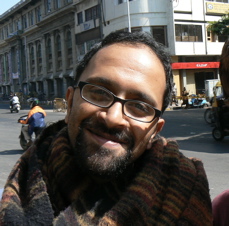
Vinay is the founder of Swabhava, another ‘connective’ organization with several purposes: (1) Providing resource information as well as linkages to resources on issues like sexuality, HIV/AIDS, sexually transmitted infections and sexual health issues.
(2) Building an online library system, where information collected and developed at the Swabhava Research and Resource Centre can be made accessible worldwide.
(3) Providing a safe forum for individuals and social organizations to interact with each other personally and online.
As usual, Swabhava is also a magnet for LGBT (mostly G) folks who collect weekly to hold ‘Good as You’ (goodasyoublr@yahoogroups.com) meetings, a support and social group .
I almost made it to one of their weekly meetings but was delayed by thirty minutes and missed the group. They collect in the modest office of Swabhava in the Shanthinagar district of town.
On their website Good As You states it started in February 1994 as a safe space for LesBiGay people to discuss, debate, share views and information which will help them to come to terms with their sexuality. It has had at least a thousand participants over the last 5 years.
Good As You also brings out a quarterly newsletter in both English and Kannada called “Sangha Mitra”. As well, it also helped sponsor the first ever rights seminar organized in India by some students of the National Law School of India University, Bangalore.More recently it has also set up a phone helpline.
Vinay’s early professional work was in advertising. Feeling isolated at the time he started attending GaY’s (Good as You) casual meetings. After a while he recognized the need to formalized the structure and functions of the group.
In 1999 he wanted to expand the wisdom and mission of GaY to a larger scale and started Swabhava (‘inner character’). It now offers education and sensitivity training to private NGOs, public organizations (police, firemen, teachers, health care agencies, etc) and commercial companies in the state of Karnataka (where Bangalore is the state capital) who deal in human services.
He focuses his workshops on HIV, alternative sexualities, child abuse, women’s issues and sex workers, also weaving into his presentations the theme of human/equal rights–not an easy task in class divided India.
 Working around such sensitive issues, Vinay constantly treads among numerous political stumbling blocks and conservative attitudes in the state. One of the most difficult issues is working, along with other pro-gay organizations, to remove Article 377 of the national statutes that criminalize homosexual activity. “Our political system is so corrupt it is impossible to know which way our lobbying and advocacy will go—or if it will have any effect. To the bureaucrats in Delhi our issues are water off a duck’s back; they get lost in a vast system.”
Working around such sensitive issues, Vinay constantly treads among numerous political stumbling blocks and conservative attitudes in the state. One of the most difficult issues is working, along with other pro-gay organizations, to remove Article 377 of the national statutes that criminalize homosexual activity. “Our political system is so corrupt it is impossible to know which way our lobbying and advocacy will go—or if it will have any effect. To the bureaucrats in Delhi our issues are water off a duck’s back; they get lost in a vast system.”
However, a recent study conducted by the United Nations made many politicians sit up and listen. It described how India’s archaic anti-gay law was hindering adequate measures to effectively combat the AIDS epidemic, which has now spread to more than 5.7 million Indians.(See News & Reports 2006, #25)
Questionable Blessing
Talking to Vinay he brought up an issue that I heard echoed several times while in India: the flood of money from the Gates Foundation (Microsoft) into India. (The state of Karnataka was allotted a hundred million dollars.)
On the surface the money seemed a god-send but as I heard from different leaders of grass roots organizations, the money has brought bureaucratic problems and ethical questions.
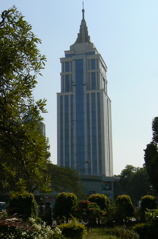 In short, working from the top with organizational charts and policies the Gates people did not consult adequately or sincerely with already-in-place local community-based LGBT/HIV/AIDS to learn what worked in the field and what did not. Thinking that money would suffice to make the locals heel to their new proposals and programs, the Indian-Gates organizers were surprised when several of these CBOs (community-based organizations)—some in business for over ten years—refused to cooperate or accept Gates money.
In short, working from the top with organizational charts and policies the Gates people did not consult adequately or sincerely with already-in-place local community-based LGBT/HIV/AIDS to learn what worked in the field and what did not. Thinking that money would suffice to make the locals heel to their new proposals and programs, the Indian-Gates organizers were surprised when several of these CBOs (community-based organizations)—some in business for over ten years—refused to cooperate or accept Gates money.
The result was confusion, debate and anger, which in the long run forced the Gates people to back off and start listening and negotiating with the locals. After three or four years now, there is better mutual understanding and cooperation in general, although some local groups still operate without Gates interference.
Another irritant for local leaders involves the sudden appearance of ‘charity’ organizations that purport to serve the HIV/AIDS crisis but whose underlying purpose is getting a piece of the big Gates pie. More than one director told me about confronting such bogus organizations and their obvious lack of integrity. Reports about kickbacks to funding agencies have been reported.
Corruption and deception have always sniffed out free money and even in a health crisisheartless hands snatch what they can without scruple.
Rex and Sangama
The third organization I visited in Bangalore was Sangama and its director Reginal (Rex) Watts. (E-mail: admin@sangama.ilban.ernet.in) New address: 9 Patel Chelluvappa Street, J.C. Nagar, Bangalore
Sangama is a social resource center with a focus on the rights of sexual minorities (lesbians, bisexuals, gays and others who are discriminated against due to their sexuality). On their website they state: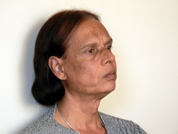 “we document information about sexual minority human rights in Kannada (local language) and English through newspaper clippings, journals, newsletters, books, reports, conference papers, films and internet. Our aim is to enlarge social, cultural and political space for sexuality minorities. We work to help these minorities to come to terms with their sexuality and live with self-acceptance, self-respect and dignity.
“we document information about sexual minority human rights in Kannada (local language) and English through newspaper clippings, journals, newsletters, books, reports, conference papers, films and internet. Our aim is to enlarge social, cultural and political space for sexuality minorities. We work to help these minorities to come to terms with their sexuality and live with self-acceptance, self-respect and dignity.
SANGAMA is facilitated through a MacArthur Foundation grant and others funders including the Gates Foundation (with whom Rex stood his ground and demanded his own contract terms).
A visit to Sangama started very informally, sitting on the floor with Rex. When I arrived at their modest 2nd story office–a small apartment in a rundown neighborhood far from the trendy yuppie ‘happening’ scene downtown—the staff were about to finalize plans for a sexual minority rights rally in Mysore (three hours away by train) the next day. The plan was to march from the ornate Mysore Palace (home to one of India’s wealthiest maharajas) to the City Hall carrying placards of protest against sexual minority discrimination and the archaic British-made laws that criminalize homosexuality.
The staff meeting was held with all ten participants sitting barefoot on floor mats in a room with no furniture except a corner cabinet holding with a new big screen TV. In addition to the rally, there was a discussion about the group’s HIV outreach activities to sex workers and MSMs throughout the city (Bangalore has 7 million people) and the need to keep records of contacts for organizational purposed.
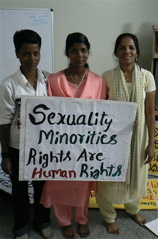 Sangama has 7 branches throughout Bangalore with about 125 paid staff (starting at $80 a month each) who connect with about 4000 marginalized people per month (usually at night in risky places like parks, railroad sidings, public toilets, under overpasses) offering education, medical referrals, condoms, social support, crisis intervention, hotline and legal referrals.
Sangama has 7 branches throughout Bangalore with about 125 paid staff (starting at $80 a month each) who connect with about 4000 marginalized people per month (usually at night in risky places like parks, railroad sidings, public toilets, under overpasses) offering education, medical referrals, condoms, social support, crisis intervention, hotline and legal referrals.
The scope of their work is daunting and overwhelming considering the pariah marginalized nature of their clientele but Sangama, founded in 1999, is well organized and committed to continue the Sisyphus challenge. (Sisyphus was a mythological figure who was condemned to push a boulder up a hill only to have it roll back down and start over.) Sometimes success happens in rescuing sex workers by training and paying them to become social workers for Sangama; needless to say this does wonders for their self-esteem.
Rex appearing gaunt with the angular facial features of a sculptor’s model appeared devoid of organizational pretensions–notable in a country where a little authority quickly goes to one’s head and one becomes more comfortable and less effective, working more to preserve a bit of power and precious salary than serve the purpose of the job itself. Rex was scolding, authoritative and demanding yet humorous, sensitive, a good listener, a corrective leader and caring father to his staff, pushing them to be accountable.
Although overworked he is nevertheless relentless in his mission to serve the underserved in Bangalore and to make non-violent trouble to rid India of it’s backward prejudiced class-ridden attitudes toward sexual minorities. “At first we were criticized for being too noisy and aggressive but now the others (human rights groups) see were are right.”
Working with marginalized sex workers to increase their awareness of health issues and offering them a channel for ‘normal’ social contact may sound worthy and admirable and perhaps inviting to outsiders with an interest in compassionate living.
But in India, probably the most class divided nation in the world, working with these fringe people (often of the Dalit class—formerly untouchables) means reaching into the heart of the country’s darkest prejudices and dirtiest districts.
Most middle class and higher class Indians are scornful, condescending and cruel to these ‘non-persons’ many of whom sleep on the streets or under bridges and are hired to carry away trash and dig out the sewers. Others populate the sex trails plying the only trade they know or were forced into by family circumstances.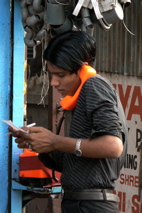
Reaching them is not easy charity work; it is daring and courageous work that plows through centuries of apartheid-like hatred, ignorance and fear. Although officially outlawed many years ago, class discrimination is still a distinct feature that labels and divides people.
Superficially the system works as a whole to the unobservant eye but stand on any busy corner and watch as the activities of daily life break down into separate layers: the female Dalit street sweepers with their twig hand brooms vainly brush the dirt and trash into piles; they hardly look up at the merchants on their way to their shops with the morning’s fish, flowers or bread.
Hurrying past the merchants without looking are casually dressed office workers carrying worn briefcases on their way to an office cell lit by a fluorescent light in a grimy office block; taxi drivers and rikshaw drivers keep to their own peers of barefoot denizens as striving yuppies and the newly affluent use them only for transport; and the rich hardly notice anyone else as they live insulated behind walls topped with broken glass inside air conditioned high-rise towers of marble and glass and ride about town in air-conditioned SUVs. HIV health and social work with the neediest is nothing short of heroic to this writer’s mind.
Meanwhile…Sangama’s march in Mysore went off well enough to merit a front-page story in ‘The Hindu’ newspaper. The story is short so it’s reproduced here:
“Nearly 300 people who described themselves as “sexuality minorities” organised a rally under the banner of Sangama here on Saturday against what they called “discrimination” they were facing. The rally was taken out as part of International Human Rights Day and they highlighted the “discrimination” they were facing because of their gender identity. They demanded that Section 377 of the Indian Penal Code be repealed. The section, they said, criminalised them and gays by terming their sexuality “against the order of nature”.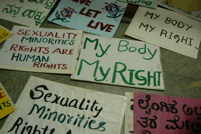
“The law was introduced in India in 1860 by the British and though it has been revoked in that country many decades ago, it continues to be in force in the country. Coupled with this, we are subject to harassment, torture and extortion by the police and anti-social elements,” according to members of Sangama.
They were also discriminated against in terms of housing, employment, property, marriage, adoption, and insurance as the Indian law did not recognise homo-bisexuals. Hence, they were deprived of education, housing, health care, ration cards, passports, voters ID cards, etc. In addition, they faced rejection from their families some of whom resorted to unethical and outdated mode of treatments to “cure” them of their preferences, the members said. They called for redrafting the civil law to give them equal opportunities in all fields”
Note: This and the other 3 stories posted about gay India 2006 describe numerous organizations with which many LGBT folks are associated. As a consequence the stories do not portray much about personal lives and feelings as they are experienced on a daily basis. For more intimate insights about the ‘inner’ lives of LGBT people I suggest the following sites: Movenpick: http://www.orinam.org/comingout.html and Gay Bombay Yahoo Group: www.gaybombay.org.
by Richard Ammon, GlobalGayz
January 2007


